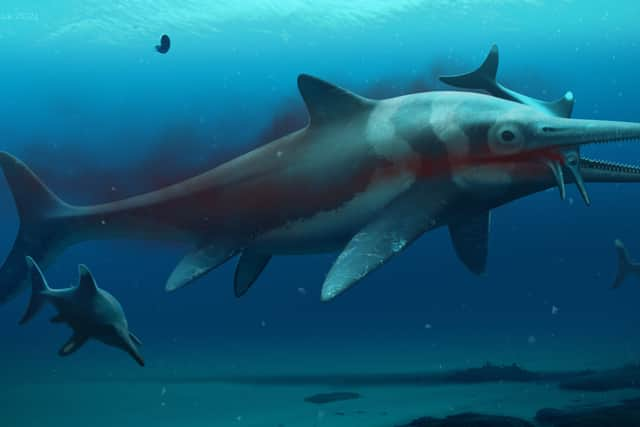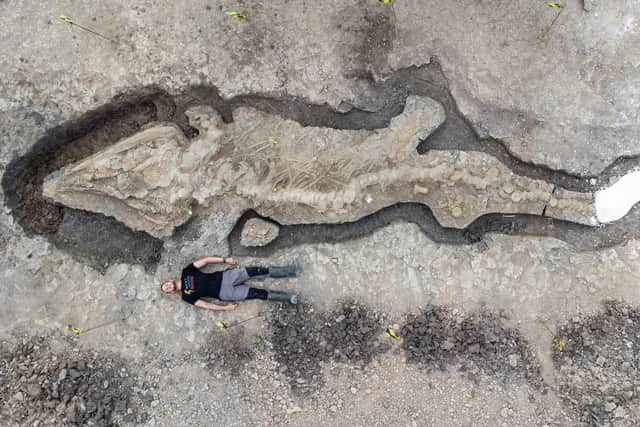Ichthyosaur fossil: Rutland Water sea dragon explained - and how important is UK reservoir dinosaur discovery?
and live on Freeview channel 276
The largest fossilised remains of a prehistoric “sea dragon” have been discovered in the Midlands, with scientists calling it one of the “greatest finds” in British palaeontological history.
The discovery is the largest and most complete fossilised skeleton of an ichthyosaur ever found in the UK.
Advertisement
Hide AdAdvertisement
Hide AdIt is thought to be around 180 million years old and measures 10 metres in length - the skull alone weighs approximately one tonne.
Here is everything you need to know about it.
What is a ‘sea dragon’?


The first ichthyosaurs - which are called sea dragons because they tend to have very large teeth and eyes - were discovered by fossil hunter and palaeontologist Mary Anning in the early 19th century.
The marine reptiles first appeared around 250 million years ago and went extinct 90 million years ago, varying in size from one to more than 25 metres in length and resembling dolphins in general body shape.
Dr Dean Lomax, a palaeontologist who has studied the species, said: “Despite the many ichthyosaur fossils found in Britain, it is remarkable to think that the Rutland ichthyosaur is the largest skeleton ever found in the UK.
Advertisement
Hide AdAdvertisement
Hide Ad“It is a truly unprecedented discovery and one of the greatest finds in British palaeontological history.”
How important is the find?


The find is not the first ichthyosaur to be discovered in Rutland: two incomplete and much smaller specimens were found during the initial construction of Rutland Water in the 1970s.
Dr Mark Evans of the British Antarctic Survey said: “I’ve been studying the Jurassic fossil reptiles of Rutland and Leicestershire for over 20 years.
“When I first saw the initial exposure of the specimen... I could tell that it was the largest ichthyosaur known from either county. However, it was only after our exploratory dig that we realised that it was practically complete to the tip of the tail.”
Advertisement
Hide AdAdvertisement
Hide AdDr Evans described the fossil as “a highly significant discovery both nationally and internationally” and said the discovery would also be “of huge importance to the people of Rutland and the surrounding area.”
How was it discovered?
The ichthyosaur was discovered by Joe Davis of Leicestershire and Rutland Wildlife Trust during a routine draining of a lagoon island at Rutland Water in February 2021.
The remains were dug out by a team of expert palaeontologists from around the UK in August and September.
Nigel Larkin, a specialist palaeontological conservator, said: “It’s not often you are responsible for safely lifting a very important but very fragile fossil weighing that much.
Advertisement
Hide AdAdvertisement
Hide Ad“It is a responsibility, but I love a challenge. It was a very complex operation to uncover, record, and collect this important specimen safely.”
The excavation of the remains will feature on BBC Two’s Digging For Britain on Tuesday 11 January at 8pm.
A message from the editor:
Thank you for reading. NationalWorld is a new national news brand, produced by a team of journalists, editors, video producers and designers who live and work across the UK. Find out more about who’s who in the team, and our editorial values. We want to start a community among our readers, so please follow us on Facebook, Twitter and Instagram, and keep the conversation going. You can also sign up to our newsletters and get a curated selection of our best reads to your inbox every day.
Comment Guidelines
National World encourages reader discussion on our stories. User feedback, insights and back-and-forth exchanges add a rich layer of context to reporting. Please review our Community Guidelines before commenting.
